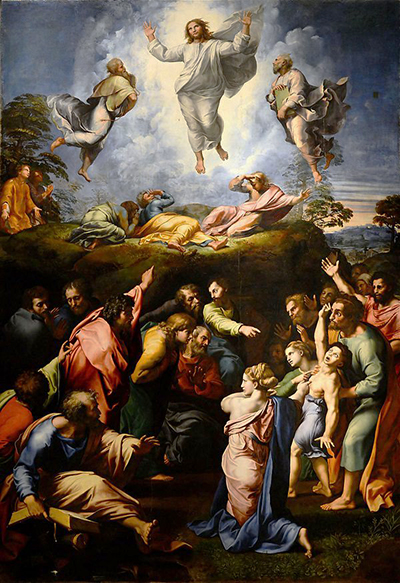Transfiguration is a large tempera on wood created by Raphael between 1516 and 1520. The painting would be the last created by the Italian Renaissance master before his death.
It depicts two distinct biblical stories linked to the Gospels of Matthew and Mark. The first is the Transfiguration of Christ, with Moses and Elijah on either side of Jesus while James and John look on. The second part of the painting recounts the story of the Apostles failing to cure a sick boy as they wait for Jesus to return.
The Transfiguration of Christ or simply Transfiguration was commissioned by Cardinal Giulio de Medici, the future Pope Clement Vii, for Narbonne Cathedral in France. In commissioning the painting, Medici reignited a rivalry between Raphael and Michelangelo during work on the Stanze di Raffaello, or the Raphael Rooms, in the Palace of the Vatican and the Sistine Chapel.
While Raphael worked on ‘Transfiguration’, Michelangelo provided drawings for Sebastiano del Piombo’s ‘The Raising of Lazarus’. Both paintings were intended for the cathedral in Narbonne.
The top half of the painting shows the Transfiguration on Mount Tabor. Jesus is depicted floating in front of clouds between the two prophets. To the left of James and John are Justus and Pastor, two saints that share the feast day of the Transfiguration (August 6).
The saints were also patrons of Cardinal Giulio de Medici and the Cathedral of Narbonne. Others believe the two kneeling figures are Saint Felicissimus and Saint Agapitus, two martyrs that are celebrated in the missal during the Feast of the Transfiguration. The lower half of the painting shows the Apostles attempting to save a boy possessed by a demon. They child is eventually saved by Jesus, who arrives following the Transfiguration.
Transfiguration was based on an early modello created in Raphael's studio by Giulio Romano. The drawing features Jesus on Mount Tabor with Moses and Elijah floating towards him.
Comparisons can be drawn between the style of this painting against the likes of El Greco's The Holy Trinity and Michelangelo's The Last Judgement.
The apostles John and James are kneeling to the right, while Peter is on the left. A second modello created by Gianfrancesco Penni illustrates two scenes like the final version.
The stylised and contorted poses of the figures in the bottom half of the ‘Transfiguration’ can bee seen as a precursor to Mannerism, while the dramatic tension between the figures and the use of chiaroscuro are similar to Baroque art.
Raphael died before completing the ‘Transfiguration’, although most of the painting was finished by the renowned artist. The painting was placed close to the painter’s head while he lay in state.
More than 16 incomplete areas and alterations are present in the painting, most of which were likely influenced by the writings of Amadeo Menes da Silva when they were published as the ‘Apocalypsis Nova’ in 1502. Instead of being sent to France, the painting was kept in Rome and exhibited at the Vatican shortly after Raphael’s death. After being held in France between 1797 and 1815, the painting was returned to Italy and is now found at the Pinacoteca Vatican in Vatican City.




